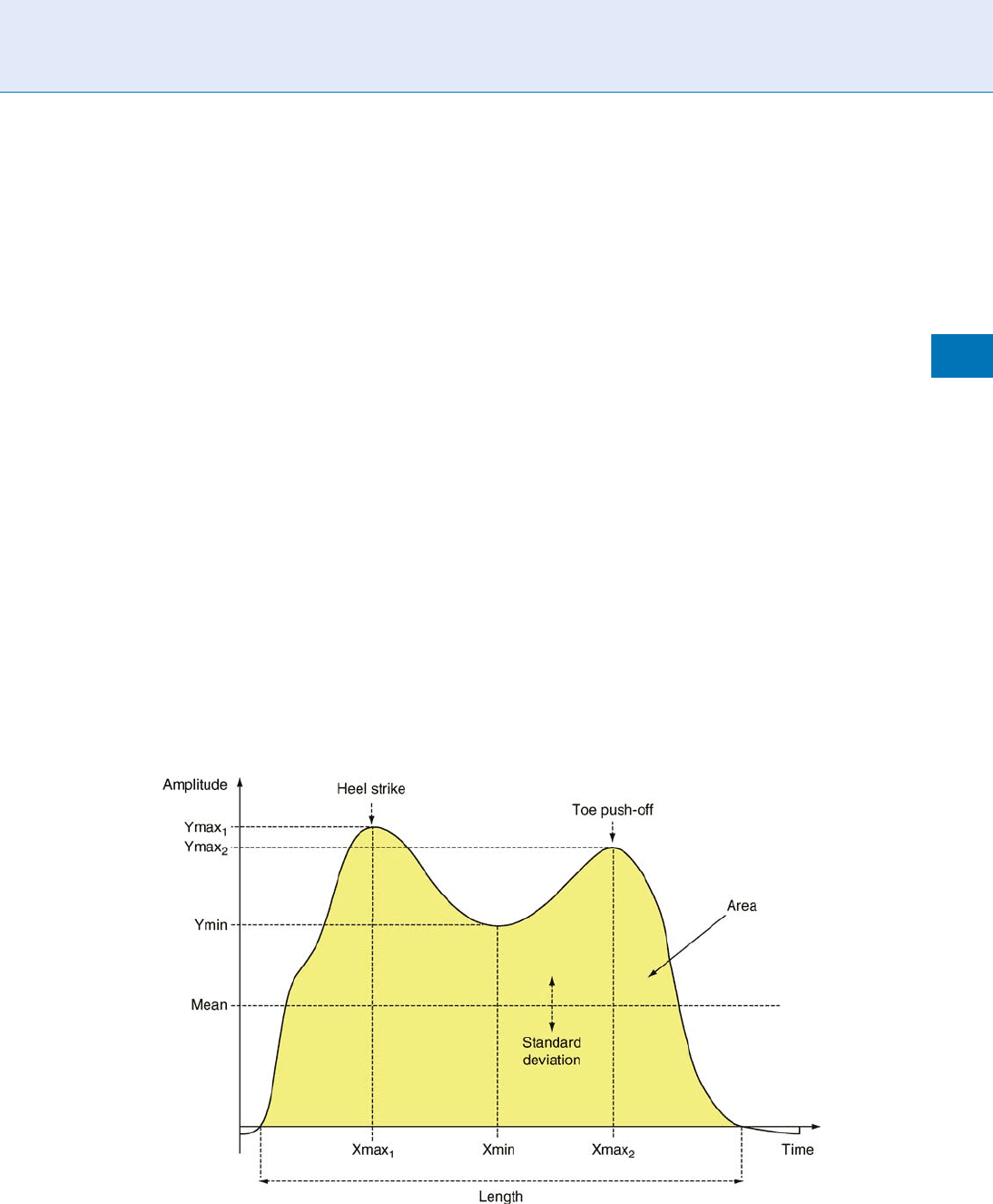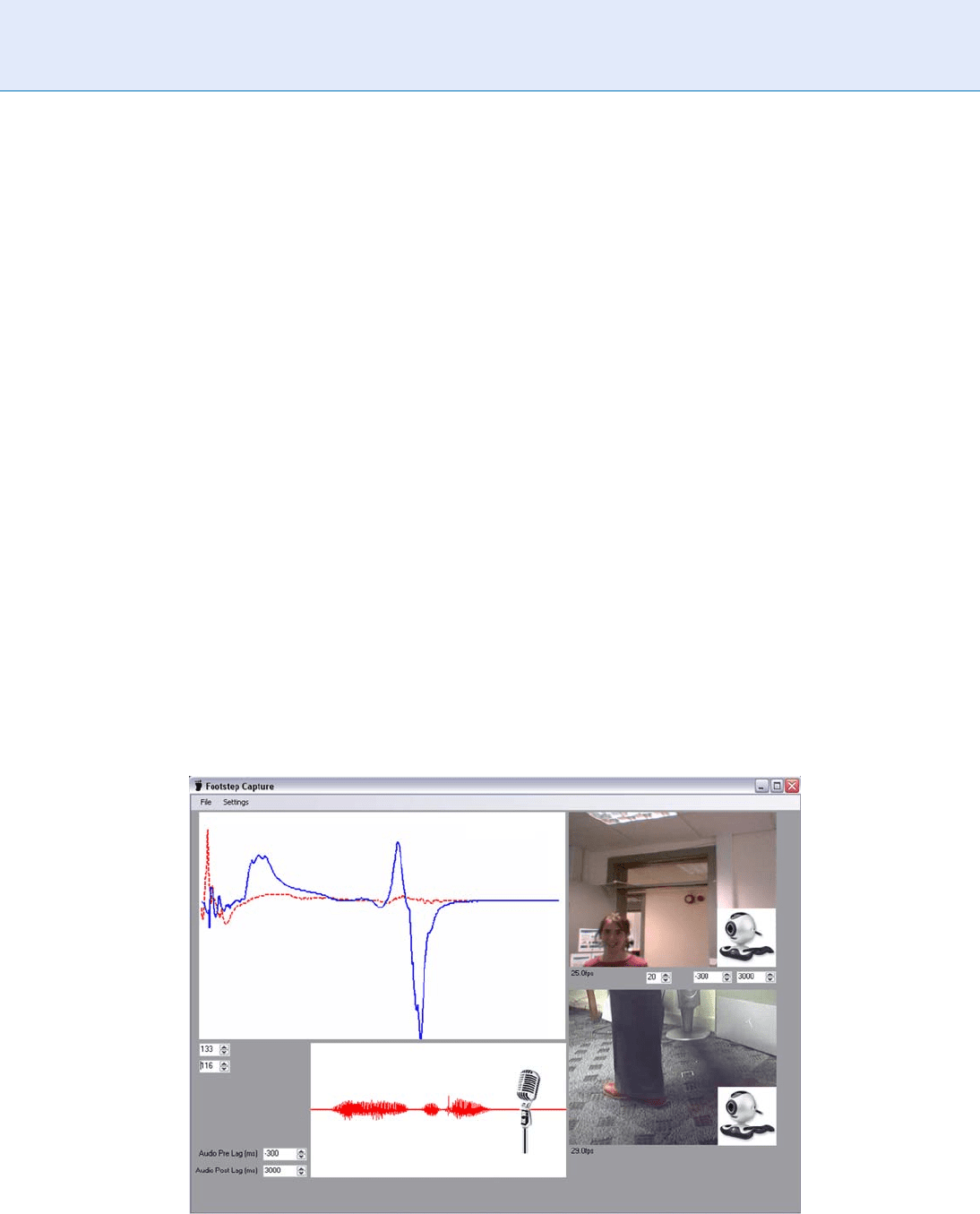Li S.Z., Jain A.K. (eds.) Encyclopedia of Biometrics
Подождите немного. Документ загружается.


Focal Distance
The distance that is required between the iris acquisi-
tion device and the iris, for the system to be able to
acquire and accurately recognize.
▶ Iris Acquisition Device
Focal Length
With respect to a lens or mirror, the distance from
the lens or mirror at which a parallel b eam of light
rays will be focused to the smallest size possible
for the lens or mirror. The focal length of a simple
converging (convex) lens can be mea sured by focus-
ing the rays from the sun to the smallest point possi-
ble and measuring the distance from the image to
the lens.
▶ Face Device
▶ Iris Device
Footprint Comparison
▶ Forensic Barefoot Comparisons
Footstep Identification
▶ Footstep Recognition
Footstep Recognition
RUBEN VERA RODRIGUEZ
1
,NICHOLAS W. D. E VA N S
1,2
,
J
OHN S. D. MASON
1
1
Swansea University, Singleton Park, Swansea,
SA2 8PP, UK
2
Institut Eure
´
com, 2229 rote des Cre
ˆ
tes, 06560
Sophia-Antipolis, France
Synonyms
Footstep identification; Footstep verification
Definition
Footstep recognition is a relatively new biometric and
is based on the study of footste p signals captured from
persons walking over an instrumented sensing area.
Since the biometric information is embedded in a
time varying signal, thereby implying some form of
action (in this case those of walking or running for
example), footsteps can be included in the group of
behavioral biometrics.
Introduction
Footstep recognition was first sug gested as a biometric
in 1977 by Pedotti [1], but it was not until 1997 when
Addlesee et al. [2] reported the first experiments. Since
then the subject has received relatively little atte ntion
in the literature and so it is perhaps of little surprise
that reported performances fall short of those achiev-
able with other, more popular, and researched
biometrics. However, recent work has demonstrated
the real potential of the footstep biometric which is
certainly not without its appeal.
One significant benefit of footsteps over other, bet-
ter known biometrics is that footstep signals can be
collected covertly with minimal client cooperation.
Other benefits lie in the robustness to environmental
noise (a limiting aspect of speaker recognition) or
lighting variability (as in the case of face recognition).
There is, however, a number of new challenges to be
addressed. Footsteps can exhibit a high degree of intra-
class variability, i.e., different footwear, persons carry-
ing heavy baggage and different walking speeds, all
550
F
Focal Distance

extraneous factors which make footstep recognition an
extremely challenging task.
In addressing these difficulties among others,
researchers have investigated footstep signals using
different sensor approaches. Systems reported in the
literature include the extraction of footstep positions
using video cameras, acoustic-based approaches which
capture the sound of footsteps [3] and, by far the most
common, under-floor contact or tactile-based sensors.
These approaches range from simple ON/OFF sensors
that indicate the position of the footstep [4–7] to more
sophisticated sensors that capture transient pressure
[1, 2, 8–13]. Pressure sensors generally measure the
ground reaction force (
▶ GRF). An example GRF pro-
file for a single footstep signal captured from the sensor
approach reported in [13] is shown in Fig. 1. Generally
there are two peaks to the GRF profile, the first peak is
attributable to the heel strike and the second to the toe
push-off as the body is propelled forward. Figure 1 also
illustrates some of the most common geometric fea-
tures (maximum, minimum and mean values) as used
in the works of [9, 12, 14] for subsequent classification.
Reported performances vary widely. The most statis-
tically meaningful results obtained for footstep recogni-
tion with an identification protocol relate to a database
comprised of 1,680 footsteps from 15 persons [9]. Here
an accuracy of 93% was reported. For the case of verifi-
cation as a protocol, best results relate to a database
comprised of 3,147 footsteps from 41 persons [15].
Equal error rates (EERs) of 9.5 and 13.5% are reported
for development and evaluation sets respectively.
Results to date are promising and show that the use
of footsteps as a biometric warrants further
investigation.
The following sections present an overview of dif-
ferent applications of footstep signals and a review of
published literature which has investigated the use of
footsteps more specifically for biometrics.
Applications
It is possible to classify different biometric techniques
according to the original application of the biometric
signal. In the case of the fingerprint and hand geometry
biometrics, signals are captured with the sole application
of biometrics; whereas for speech, for example, the main
application is communication, and biometrics can be
considered a secondary application. Other biometrics
such as the footsteps are in the middle of this range. A
footstep is an action that can be captured for several
applications. Potential uses of footstep signals in the
Footstep Recognition. Figure 1 Example of a GRF profile against time for a single footstep. The first peak corresponds
to the heel strike and the second corresponds to the toe push-off.
Footstep Recognition
F
551
F

literature include medicine, surveillance, smart homes,
multimedia, and biometrics, none of them dominating
and therefore this overview presents the entire spectrum.
In the field of medicine, footstep signal s have been
used to analyse different gait deficiencies by comparing
normal and pathological patterns of footstep pressure
signals. Following early work on biomechanics, in 1977
Pedotti [1] studied the three orthogonal components
of the GRF signal using a square force plate with four
piezoelectric transducers placed in the corners, similar
to other systems used later for biometrics [2, 9, 10, 12].
He studied visually around 4,500 footsteps from 65
normal and 165 pathological subjects and observed
stride symmetry between the left and the right feet
for normal subjects but not for pathological subjects;
furthermore, Pedotti noted low intra-person variabil-
ity, leading to one of the first suggestions to the use of
footsteps as a biometric. Commercial products today
provide high resolution pressure image sequences from
thin sensor mats created by printing processes. These
systems are used in medicine to study for example the
plantar pressure profiles, identify asymmetries between
left and right feet, review dynamic weight transfer
and local pressure concentrations, or identify areas of
potential ulceration amongst others.
More focused on the detection of footsteps for sur-
veillance applications, footstep signals have been used to
detect human presence in a determined area. The work
described in [3] reports some experiments carried out
with a database comprised of five people walking ten
times toward a microphone. The aim of the research
was not only on footstep detection but person identifi-
cation using mel-cepstrum analysis. Other work
reported in [16] used piezoelectric accelerometers to
detect impulses induced by walking. Footsteps were
identified from three or more impulses where the
sensor was excited at its resonant frequency, having
satisfactory results in most occasions.
One particularly appealing application of footstep
signals is found in the field of smart homes. In 2000
Mori et al. [17] developed a robotic room where multi-
ple sensors were distributed in several locations. Foot-
step signals were collected from a distribution of force
sensing resistors (FSRs) to specify human position in
the room. A total number of 252 FSRs were installed in
a 200 mm 200 mm lattice shape. More recent work
on the same floor [ 4] (2002) increased the spatial
resolution of the sensors to a 64 64 switch sensor
array in a 500 mm
2
space. With this higher resolution,
experiments determi ned the positions of a human and
a four-wheeled cart and distinguished between them.
In 2004 Murakita et al. [5] reported a system for
tracking individuals over an area of 37 m
2
employing
basic block sensors of 18 cm
2
. The system was capable of
tracking two different people when separated by more
than 1.4 m but failed to track people in a crowded area
due to the low spatial resolution and a low capture rate of
5 Hz. Making use of the hardwar e developed for the
Active Floor [2], in 2001 Headon and Curwen [18]
used the vertical component of the GRF and a hidden
Markov model (HMM) classifier to recognise different
movements including stepping, jumping, or sitting
down. Applications of such a system exist in safety (i.e.,
fall detection for the elderly) and entertainment (i.e.,
video games). More recently, in 2008 Liau et al. [19]
developed a system which used load cells over an area
of 4 m 4 m to track people and addressed the cross-
walking problem where the paths of two or more
people intersect.
Footstep signals have also been used for multimedia
applications. In 1997 Paradiso et al. [20] developed
a system which he called The magic carpet to be used
in an audio installation where users created and
modified complex musical sounds and sequences as
they wandered about the carpet. The sensor floor
comprised a 16 32 grid of piezoelectric wires in an
area of 1.8 m 3 m carpet. Later in the same year, the
same laboratory developed a system installing PVDF
(polyvinylidene fluoride) and FSR sensors into a danc-
ing shoe [21]. The goal was to capture many degrees of
expression and use them to drive music synthesizers
and computer graphics in a real-time performance.
More recently, in 2005 Srinivasan et al. [8] developed
a portable pressure sensing floor constructed of mod-
ular high resolution pressure sensing mats. A sensor
mat comprised 2,016 sensors made from a pressure
sensitive polymer and covered an area of 62 cm 53
cm, sampling each sensor at a frequency of 30 Hz.
Initial applicati ons of the system were to study interac-
tive dance movement and video game controlling.
Review of Footsteps as a Biometric
Review of footsteps as a biometric is now an addressed
work in the open literature which considers the use of
footsteps specifically as a biometric. One of the first
investigations into footstep recognition was reported
552
F
Footstep Recognition

by UK researchers in 1997 [2]. They reported experi-
ments on a database of 300 footsteps signals that were
captured from 15 walkers in one session. The system
was comprised of four load cells measuring the vertical
component of the GRF and placed on the corners of a
tile working at a sampling frequency of 250 Hz. They
divided the database into train and test and an identi-
fication accuracy of 91% was achieved with an HMM
classifier and samples from the GRF of a single footstep
signal as features.
In 2000, and using a similar sensor approach, a
group in the USA reported results on a database of
1,680 footstep signals collected from 15 persons using a
frequency sampling of 150 Hz [9]. Signals were collect-
ed from both left and rig ht feet and different footwear
having 20 footsteps per condition using half of them
for training and half for testing. Ten geometric features
were extracted from the GRF of a single footstep signal
including the mean value, the standard deviation,
maxima, and minima, etc. They considered each com-
bination of user, foot, and shoe type as a cluster. Then a
nearest neighbour classifier was used to measure the
Euclidean distance of a footstep from the test set to
each cluster. An identification accuracy of 93% was
reported regardless of whether the correct shoe or
foot was given. In 88% of the cases, a user’s footstep
was more similar to other footsteps for that same user
than for another user, concluding from these results
that footwear does not greatly affect the ability of their
approach to identify the user by his footsteps.
While focused toward the study of gait, a group from
Switzerland [10] developed in 2002 a system fusing
data acquired from 3 tiles of 4 piezo force sensors
each and video cameras. A database of 480 footsteps
was collected from 16 persons walking barefoot using a
sampling frequency of 300 Hz. The database was fur-
ther divided into train and test. They studied different
feature extraction techniques as geometric features
from GRF [9] and phase plane (as area within the
curve, position of the loop, maxima, minima, etc.).
The best verification performance was achieved using
the power spectral density (PSD) of the derivative GRF
of footsteps signals in the band of 0–20 Hz with
generalized principal component analysis (GPCA),
obtaining a verification EER of 9.5% with an Euclidean
distance classifier.
A Korean group reported a system in 2003 [6] that
used 144 simple ON/OFF switch sensors in a total area
of 1m 3m. Stride data (connected footsteps) was
collected from ten persons who each one walked
50 times across the ubiFloor resulting in a database of
500 walking samples. Then the database was divided
into training , validation, and testing data randomly.
The position of several connected footsteps was used as
users walking features instead of the pressure of one
footstep, as proposed in [2, 9]. An accuracy of 92% was
reported with a multi-layer perceptron (MLP) neural
network used as an experimental identification method.
In 2004 a group from Finland investigated footstep
recognition using electro mechanical film (EMFi). Long
strips of the sensor material were laid over an area
covering 100m
2
. A database of around 440 footstep
signals (of both feet) was collected from 11 persons at
a frequency rate of 100 Hz. In their publication [11]
they reported experiments with a two level learning
vector quantisation (LVQ) based classifier and consid-
ered three consecutive footsteps of a person to carry
out a single test. On the first level each of the three
single footstep signals was classified independently,
and on the second level the decisions of the three
consecutive footsteps were taken into account having
a final acceptance if a majority of the footsteps were
classified to the same class. The recognition rate
reported was 89% of accuracy with an 18% of rejection
rate. In the same year they reported different experi-
ments [14] based on the same database. Geometric
features were extracted from the GRF profiles as in
[9] and first FFT coefficients. Using a distinction-
sensitive LVQ (DSLVQ) classifier for a single footstep,
an identification accuracy of 70% was achieved. Later
in 2005, they presented experiments in [22] combining
different feature sets using a two level classifier. On the
first level three different feature sets were extracted
from a single footstep as geometric features from the
GRF as in [14], FFT of GRF with PCA, and FFT of the
derivative GRF with PCA. Then, a product rule was
used to combine the three results obtained. On the
second level different footsteps from the same person
were combined using an average strategy. These experi-
ments were done for two classifiers: LVQ and a MLP
neural network. Results were better for MLP classifier
in all cases, having a recognition rate of 79% for the
case of a single footstep and a 92% for three consecu-
tive footsteps.
In 2005 a group from Southampton (UK) [7]
reported trials with a system comprising 1,536 sensors
arranged in a 3 m 0.5 m rectangular strip with an
individual sensor area of 3 cm
2
. A database of 180
Footstep Recognition
F
553
F

signals was collected from 15 people without wearing
footwear at a frequency of 22 Hz. Each person walked
over the mat 12 times and in each case two complete
gait cycles (4 foot falls) were captured. Three features
were extracted: stride leng th, stride cadence, and heel-
to-toe ratio. An identification accuracy of 80% was
reported using a nearest neighbor classifier to measure
the Euclidean distance between each feature vector and
the mean feature vector of the experimental popula-
tion, i.e., the whole database. This work along with the
early work of [6], differs from other published material
in using binary signals rather than sampled waveforms
and capture stride information from a short series of
footfalls. Stride characteristics are also considered by
[11, 22] as stated above.
In 2006 another group from Southampton [12]
investigated a system similar to the work in [2, 9]. A
database of 400 signals was collected from 11 people.
Using geometric features extracted from GRF profiles
as in [9] an identification accuracy of 94% was
achieved using a nearest neighbor classifier in the
same way as in [7].
More recently, in 2007, a research group from
Swansea (UK) presented in [13, 15] experiments
obtained with a database comprised of 3,174 footsteps
from 41 different persons in different sessions and shoes
from two piezoelectric transducers sampled at a fre-
quency of 1,024Hz. The database was further divided
into independent development and evaluation datasets
adopting a standard best practice evaluation strategy,
and therefore, presenting more statistically meaningful
results and potentially more reliable predictions of per-
formance. The database is freely available to the research
community [23]. Due to the amount of data collected,
a semi-automatic footstep capture system was devel-
oped to facilitate automatic labeling and rapid manual
validation. Figure 2 shows a screenshot of the footstep
capture system user interface. A microphone captured
a spoken ID used for automatic speaker recognition to
label the data (bottom part of Fig. 2); and two video
cameras, one recording the face and the other the foot
(top and bottom right part of Fig. 2 respectively), were
used for manual data validation; the sensor responses
are illustrated in the top left part of Fig. 2 as a function
of time (horizontal axis). For feature extraction, two
approaches were followed, namely geometric and ho-
listic. The geometric approach was based on the ex-
traction of main characteristic points of the footstep
profile: the area, mean, length, maxima/minima, etc.
The holistic approach was based on both sensor out-
puts and the GRF profile after PCA to reduce di-
mensionality of the data. In [13] two different
Footstep Recognition. Figure 2 Screenshot of the footstep capture system software developed in [13, 15].
554
F
Footstep Recognition

classifiers, a nearest neighbor and SVM were also com-
pared and findings were as expected that SVM outp er-
forms the NN, and surprising ly holistic features
outperforms the geometric features. Results of 9.5
and 11.5% EER were obtained for development and
evaluation sets respectively for holistic features with an
SVM classifier. Following best-practice, a formal assess-
ment protocol was defined for the footstep recognition
evaluation presented in [15]. The protocol reflects that
utilized by the international NIST speaker recognition
evaluations. Also, an optimization of the two feature
approaches was carried out obtaining results of 9.5%
EER for the development set and 13.5% EER for the
evaluation set using optimized holistic features with an
SVM classifier. EER given of 13.5% corresponds to
1,697 errors of each class (false acceptance and false
rejection) from a total number of 25,143 tests. Such
simple analysis allowing comparison across systems
comes from adopting the task with verification. Work
is ongoing w ith a multi-sensor stride capture system
with the primary goal of improving confidence in the
assessment of footsteps as a biometric.
Table 1 presents a comparison of this related work.
The second column shows that relatively small data-
base sizes is a common characteristic of the earlier
work certainly judged in relation to other biometric
evaluations where persons are normally counted in
hundreds or thousands and the number of tests per-
haps in many thousand s. A maximum number of
16 persons and 1,680 footstep examples were gathe red
in all cases except in [13, 15] which reports results on
3,147 footsteps and 41 per sons. In each case, except for
[7, 12], the databases are divided into training and
testing sets, but none use independent development
and evaluation sets, with exception of [13 , 15], a limi-
tation which makes performance predictions both
difficult and unreliable. Identification, rather than ver-
ification, was the task considered in all but three of the
cases, the exceptions being [10, 13, 15]. Identification
has the benefit of utilizing the available data to a
maximum but suffers from well known scalability pro-
blems in terms of the number of classes in the set. Also, it
is interesting to point out that some systems present
classification results for stride data (consecutive
Footstep Recognition. Table 1 A comparison of different approaches to footstep recognition 1997–2007
Group, year
Database
(total steps/
persons) Technology Features Classifier Results
The ORL Active
Floor (UK) 1997 [2]
300 steps,
15 persons
Load cells Sub sampled GRF HMM ID rate: 91%
The Smart
Floor (USA)
2000 [9]
1,680 steps,
15 persons
Load cells Geometric from GRF NN ID rate: 93%
ETH Zurich
(Switzerland)
2002 [10]
480 steps,
16 persons
Piezo force
sensors
Power spectral
density
Euclidean
density
Verif EER: 9.5%
Ubifloor (Korea)
2003 [6]
500 steps,
10 persons
Switch
sensors
Position of several
steps
MLP neural
net.
ID rate: 92%
EMFi Floor (Finland)
2004 [11, 14, 22]
440 steps,
11 persons
Electro
mechanical
film
Geometric from GRF,
and FFT
MLP neural
net. and
LVQ
Best ID rate [22] of 92%
using three footsteps as
test
Southampton
University (UK)
2005 [7]
180 steps,
15 persons
Resistive
(switch)
sensors
Stride length,
cadence and heel-to-
toe ratio
Euclidean
distance
ID rate: 80%
Southampton
University (UK)
2006 [12]
400 steps,
11 persons
Load cells Geometric from GRF NN ID rate: 94%
Swansea
University (UK)
2007 [13,
15]
3,174 steps,
41 persons
Piezoelectric
sensors
Geometric and
holistic
SVM [15] Verif EER: 9.5% for
Devel, 13.5% for Eval
Footstep Recognition
F
555
F

footsteps) [6, 7, 11, 14, 22] while the rest only for a
single footstep [2, 9, 10, 12, 13, 15]. In [22] an identi-
fication accuracy of 79% using a single footstep as a
test was improved to 92% when three consecutive
footsteps were used. This equates to a relative improve-
ment of 16%.
Summary
Footstep recognition is a relatively new biometric rela-
tive to other biometrics in terms of the research
reported in the literature. As reviewed, footstep sig-
nals have been used for different applications, thus
different capture systems have been developed. In the
field of biometrics the same trend is observed;
researchers have developed systems w ith different sen-
sors, extracting different features, and with different
assessment protocols. Recently, in 2007, the world’s
first freely available footstep database was released to
the research communit y [23]. Of particular impor-
tance to this development is, not only the size of the
database both in terms of the number of footsteps and
clients, but the standard, best practice evaluation pro-
tocols that accompany the database. For the first time
researchers will be able to develop and assess new
approaches on a common and meaningfully sized data-
base. As has happened for many other biometric mod-
alities, it is hoped that this will stimulate new interest
in the footstep biometric, lower the cost of entry and
provide a solid foundation for future research.
Given its current stat e of development the future of
footstep recognition research is difficult to predict.
Some obvious avenues include new features and
novel normalization approaches to reduce the effects
of extraneous factors. Other possibilities include fur-
ther investigation into connected footsteps, i.e., stride
information, information that isn’t captured by single
footstep systems. This research would explore the mid-
dle ground between footsteps and gait. Gait is another
biometric that finds applications in different areas such
as in medicine, the sports industry, and biometrics. In
the biometrics context, gait aims to recognise persons
from a distance using walking characteristics extracted
from video recordings. In contrast, footsteps are a
more controlled biometric due to the fixed, con-
strained sen sing area. It would thus seem natural for
future research to investigate the fusion of the two
biometrics.
Related Entries
▶ Gait Recognition
References
1. Pedotti, A.: Simple equipment used in clinical practice for eval-
uation of locomotion. IEEE Trans. Biomed. Eng. BME-24(5),
456–461 (1977)
2. Addlesee, M.D., Jones, A., Livesey, F., Samaria, F.: The ORL
active floor. IEEE Pers. Commun. 4(5), 35–41 (1997)
3. Shoji, Y., Takasuka, T., Yasukawa, H.: Personal identification
using footstep detection. In: Proceedings of 2004 International
Symposium on Intelligent Signal Processing and Communica-
tion Systems, pp. 43–47 (2004)
4. Morishita, H., Fukui, R., Sato, T.: High resolution pressure
sensor distributed floor for future human–robot symbiosis
environments. In: Proceedings of 2002 IEEE/RSJ International
Conference on Intelligent Robots and Systems, vol. 2, pp. 1246–
1251 (2002)
5. Murakita, T., Ikeda, T., Ishiguro, H.: Human tracking using floor
sensors based on the Markov chain Monte Carlo method. In:
Proceedings of the 17th International Conference on Pattern
Recognition (ICPR), vol. 4, pp. 917–920 (2004)
6. Yun, J.S., Lee, S.H., Woo, W.T., Ryu, J.H.: The user identification
system using walking pattern over the ubiFloor. In: Proceedings
of International Conference on Control, Automation, and Sys-
tems, pp. 1046–1050 (2003)
7. Middleton, L., Buss, A.A., Bazin, A.I., Nixon, M.S.: A floor
sensor system for gait recognition. In: Proceedings of Fourth
IEEE Workshop on Automatic Identification Advanced Technol-
ogies (AutoID’05), pp. 171–176 (2005)
8. Srinivasan, P., Birchefield, D., Qian, G., Kidane, A.: A pressure
sensing floor for interactive media applications. In: Proceedings
of the 2005 ACM SIGCHI International Conference, vol. 265,
pp. 278–281 (2005)
9. Orr, R.J., Abowd, G.D.: The smart floor: a mechanism for natural
user identification and tracking. In: Proceedings of Conference on
Human Factors in Computing Systems, pp. 275–276 (2000)
10. Cattin, C.: Biometric authentication system using human
Gait. Swiss Federal Institute of Technology, Zurich. PhD
Thesis (2002)
11. Suutala, J., Pirttikangas, S., Riekki, J., Roning, J.: Reject-optional
LVQ-based two-level classifier to improve reliability in footstep
identification. Lecture Notes Comput. Sci. Springer, Berlin 3001,
182–187 (2004)
12. Gao, Y., Brennan, M.J., Mace, B.R., Muggleton, J.M.: Person
recognition by measuring the ground reaction force due to a
footstep. In: Proceedings of Ninth International Conference on
Recent Advances in Structural Dynamics (2006)
13. Vera-Rodriguez, R., Evans, N.W.D., Lewis, R.P., Fauve, B.,
Mason, J.S.D.: An experimental study on the feasibility of foot-
steps as a biometric. In: Proceedings of 15th European Signal
Processing Conference (EUSIPCO’07), pp. 748–752. Poznan,
Poland (2007)
556
F
Footstep Recognition

14. Suutala, J., Roning, J.: Towards the adaptive identification of
walkers: automated feature selection of footsteps using distinc-
tion-sensitive LVQ. In: Proceedings of International Workshop
on Processing Sensory Information for Proactive Systems,
pp. 61–67 (2004)
15. Vera-Rodriguez, R., Lewis, R.P., Evans, N.W.D., Mason, J.S.D.:
Optimisation of geometric and holistic feature extraction
approaches for a footstep biometric verification system. In:
Proceedings International Summer School for Advanced Studies
on Biometrics for Secure Authentication. Alghero, Italy (2007)
16. Mazarakis, G.P., Avaritsiotis, J.N.: A prototype sensor node for
footstep detection. In: Proceedings of the Second European
Workshop on Wireless Sensor Networks, pp. 415–418 (2005)
17. Mori, T., Sato, T., Asaki, K., Yoshimoto, Y., Kishimoto, Y.: One-
room-type sensing system for recognition and accumulation
of human behavior. In: Proceedings of 2000 IEEE/RSJ Interna-
tional Conference on Intelligent Robots and Systems, vol. 1,
pp. 344–350 (2000)
18. Headon, R., Curwen, R.: Recognizing movements from the
ground reaction force. In: Proceedings of the 2001 Workshop
on Perceptive User Interfaces, vol. 15, pp. 1–8. Orlando, USA
(2001)
19. Liau, W.H., Wu, C.L., Fu, L.C.: Inhabitants tracking system in a
cluttered home environment via floor load sensors. IEEE Trans.
Autom. Sci. Eng. 5(1), 10–20 (2008)
20. Paradiso, J., Abler, C., Hsiao, K., Reynolds, M.: The magic carpet:
physical sensing for immersive environments. In: Proceedings of
CHI’97, pp. 277–278. Atlanta, USA (1997)
21. Paradiso, J., Hu, E.: Expressive footwear for computer-augment-
ed dance performance. In: Proceedings of the First international
Symposium on Wearable Computers. IEEE Computers Society
Press, pp. 165–166. Cambridge, USA (1997)
22. Suutala, J., Roning, J.: Combining classifiers with different foot-
step feature sets and multiple samples for person identification.
In: Proceedings of International Conference on Acoustics, Speech,
and Signal Processing (ICASSP), vol. 5, pp. 357–360 (2005)
23. S.U.: Footstep recognition at Swansea University. Available at
http://eeswan.swan.ac.uk
Footstep Verification
▶ Footstep Recognition
Footwear Marks
Footwear marks is an umbrella term describing the
various types of marks that an item of footwear can
produce through its use. The terms outsole print, im-
print and impression, or footwear print, imprint and
impression are collectively called footwear marks.
▶ Footwear Recognition
Footwear Recognition
MARIA PAV LOU,NIGEL M. ALLINSON
University of Sheffield, Mappin Street, Sheffield, UK
Synonyms
Outsole pattern matching; Shoeprint matching
Definition
Footwear recognition is the process of acquiring, iden-
tifying, and verifying the marks of the outsole (under-
side) patterns of a shoe. These marks arise as a result of
the normal use of footwear in many conditions and
environments. Footwear recognition can be used by
the police and other law enforcement agencies in the
identification of crime suspects.
Introduction
Although footwear recognition in a strict sense is not a
biometric, it does provide a very useful source of
intelligence and potential evidence in the application
of forensics for policing and security. As shoes are fairly
personal items of apparel with usually an extended
period of owne rship by their wearer, they could be
termed a ‘‘near-biometric.’’ Similar to latent finger-
prints,
▶ footwear marks are very frequently left be-
hind on surfaces at crime scenes [1]; and they can be
more commonly recovered than fingerprints for some
crime categories. A number of methods are then used
to develop and collect these
▶ scene marks to provide
useful evidential clues by linking patterns of movement
of suspect individual s (at crime scenes), and can even
provide strong courtroom evidence by matching a
mark to an individual shoe. This useful resource has
gained recent interest internationally, even resulting in
Footwear Recognition
F
557
F

legislative changes in the UK [2] where collected foot-
wear evidence is treated in the same way as fingerprint
and DNA evidence. Namely, they have to be provided
at time of arrest, and can be held and searched on local/
national computer systems.
Etiology, Detection and Recovery
The typical shoe comprises of three parts (see Fig. 1)–
upper, midsole, and outsole. The footwear upper is
generally constructed from a variety of hard wearing
fabrics or leather and is fashioned and colored in a
multitude of ways. The upper holds the foot firmly in
place and provides suitable support. The midsole holds
the inner sole and is also used to fasten the uppers to
the outsole. The outsole is the undersi de of the foot-
wear, made of a durable leather, rubber or poly plastic,
which provides traction and cushioning for the wearer.
Manufacturers have made great efforts in the design of
the outsole for the benefit of the wearer in varying
activities by incorporating functional and decorative
▶ tread patterns. More commonly worn leisure foot-
wear or sneakers typically have intricate tread designs
based on the shoe model theme or manufacturer logos.
What is important here is that the tread pattern is
usually very distinctive to any design of shoe model
just like the friction skin ridge patterns of fingers are
unique to an individual.
Similar to latent fingerprints, it is the contact of the
outsole with various surfaces that results in the forma-
tion of a footwear mark in a number of ways. This can
be from the deposition of dry material such as dust or
dirt, or wet materials such as water, blood or mud,
onto a surface. The removal of material from a surface
may also form a mark, leaving a negative impression
for example when stepping into and out of a shallow
pool of blood, while an indented impression can be
formed in a soft substrate such as snow or clay.
Accordingly for each type of mark there are numerous
methods by which these are detected, recorded, and
preserved. Details can be found in [1, 3]. Briefly, these
range from using specialized lighting methods, such as
oblique and multispectral lighting, and chemical devel-
opers to enhance hard to see traces which can then be
photographed. Several lifting techniques are also used
to capture deposited particle materials onto a fixing
substrate such as a
▶ gelatin pad. When a footwear
mark is left in a soft material, such as snow, specialized
plaster or molten sulphur can be used to produce a cast
of the impression. Finally a print of the outsole can be
made directly if available. This is done using dusting
techniques, such as fine aluminum powder and then
pressing onto a transparent gel sheet. More commonly
the outsole can be impregnated with a dye, and printed
onto paper, or with an oil-based liquid and printed
on special sensitized paper – a method commonly
called Printscan (see Fig. 2). This last method is
the technique most employed in Police
▶ custody
suites to produce impressions of a suspec t’s shoes.
The resulting impression can then be used for one-
to-one comparisons to provide forensic evidence, or
can be scanned for computer-based processing. The
overriding aim of all these development and recovery
techniques is to obtain as true and unaltered a repre-
sentation of the mark as possible for later processing
and examination.
Uniqueness and Application
Intuitively the uppers of an item of footwear are im-
mediately more useful in identifying the make or
model of a shoe. This is because of their styling, color-
ing, and the presence of manufacturer logos, with
detailed information being readily obtain able from
outlets and manufactures. However the uppers and
any associated markings are rarely encountered as
forensic evidence. The impressions and marks pro-
duced by the outsole are more readily fou nd and can
contain sufficient characteristic information to ascer-
tain the manufacturer, model, and potentially the
wearer. These characteristics originate in a number of
Footwear Recognition. Figure 1 Components of a
typical athletic shoe, comprising the upper, midsole, and
outsole.
558
F
Footwear Recognition

ways starting from the manufacture process. Footwear
manufactures use a number of processes for the pro-
duction of outsoles [1] resulting in a varying degree
of
▶ process artifacts and defects remaining in the
final product. These are one of the three useful char-
acteristics of an outsole, which also comprises the
outsole tread pattern and the accumulated wear-
and-tear artifacts. Of these characteristics only the
wear-and-tear artifacts are unique provided they have
occurred due to a random process where something is
added or taken away from the outsole that either
causes or contributes to making the outsole unique.
Such artifac ts include nicks, cuts, scratches and
▶ feathering of the rubber material due to the normal
usage of the footwear. These can be called ‘‘individual
characteristics’’ while the outsole tread pattern and
other manufacture defects are termed ‘‘class character-
istics’’ which are distinct to a particular model of foot-
wear and the process of its production, such as its
outsole mold.
The identification and use of these characteristics
have different meaning and implications. In a forensic
setting the class characteristics are important as they
provide information on the manufacture and model of
the footwear worn and also its size. This is useful when
restricting a suspect list based on physical build/size,
accessibility of rare/expensive items and even geo-
graphical distribution of crimes. Once candidates of
the same footwear class are available only then can
comparisons be made on individual characteristics.
Forensic examiners will look for common individual
characteristics between items of recovered footwear,
their reproduced marks and marks found as evidence
which provide conclusive links and can be used as
court room evidence. Provided there are sufficient
individual characteristics between an outsole and a
recovered mark it may be possible to state that the
outsole created the outsole mark to court room stan-
dards of evidence. Outside the forensic setting, foot-
wear class characteristics can be very useful for
screening and intellig ence gathering. The footwear
of a suspect can be collected and from which its class
characteristics are ascertained. Usually suspects will be
offenders detained or held on an unrelated offense and
may have their footwear proactively compared with
evidence collected at an earlier time in relation to
other offenses in a local area, such as burglaries.
If a link is made between an arrestee and marks
found at crime scenes then it can provide law enforce-
ment officers with some important information
with which to interrogate while the arrestee is still in
custody.
Comparison and Identification
Methods
The comparison of class and individual characteristics
of an outsole have been largely carried out by experi-
enced forensic professionals, as an intimate
Footwear Recognition. Figure 2 Making an outsole pattern print on sensitized paper with the Printscan method.
Footwear Recognition
F
559
F
